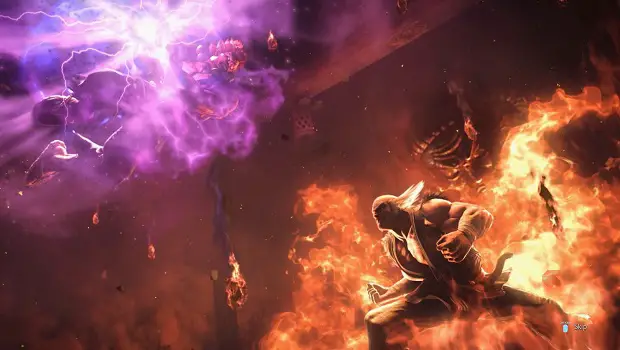It’s a testament to how much the Tekken franchise has evolved; ever since the good ol’ PS1 days, the 3D fighter has undergone some pretty distinct graphical and gameplay changes, and the seventh main installment shows this quite spectacularly. While there are some hiccups here and there, Tekken 7 is an enjoyable and satisfying entry in the long-running fighting franchise.
The most prolific story in the Tekken franchise is the Mishima saga, and this game’s narrative is all about that dysfunctional family. As the story begins, the Mishima Zaibatsu and G Corporation are feuding together, with the latter getting the upper hand due to the absence of Jin after the events of Tekken 6. With its leader MIA, Heihachi Mishima has no qualms about taking over the Mishima Zaibatsu and continuing his quest to destroy his son, Kazuya. In the meantime, Heihachi announces a new Iron Fist tournament to attract fighters from all across the globe while more of his dubious past is revealed.
Tekken 7 is the first main console entry since 2009 (or 2012 counting Tag Tournament 2), and gameplay is more or less similar to its predecessor. Two fighters go one-on-one against each other as they duke it out on the stage. Each of the four face buttons corresponds to a different limb, and different combinations can be strung together to create combos. There’s been some rebalancing to the mechanics, however; while juggling and getting cornered are still prevalent issues, they’re less of a nuisance compared to 6.
Additionally, the rage system returns, where fighters gain extra offensive power when they get beaten up too much. This system is reworked to not be too overpowered; it never felt like an instant win when I was facing opponents, and it isn’t an excuse to get too reckless. The rage system also grants two different techniques: rage arts (special attacks that can only be activated once you gain rage status), and rage drives (a powered-up version of an attack). Rage arts end up being a last resort, since activating them will cause you to lose rage status for the remainder of the round. They can also be blocked, so the risk vs. reward of rage techniques counters these showstoppers. These subtle changes make the main game fresh and exciting, and add a new dynamic near the end of each fight.
The game takes advantage of its hardware, and it shows: this is the prettiest looking Tekken yet. The different arenas are bursting with personality, from the fire-laden Devil’s Pit to the playful and colorful Kinder Gym. The character models for each fighter are full of detail, and that’s not counting the possibilities of customized costumes (more on that later). In short, the game is beautiful.
The cast of diverse and entertaining characters is always a Tekken strong suit, and this game doesn’t disappoint on that end. For every solid mainstay like Heihachi and Nina, you have eccentric characters like Panda and Alisa. The newcomers are also unique, from the lumbering robotic Gigas to the distinguished yet butt-kicking Claudio. Each character plays differently, and as a bonus speaks their native language, apart from characters like Lars and Alisa (due to their backstories) and Josie Rizal (who speaks English rather than her native Tagalog because both languages are spoken in the Philippines). It’s a nice touch that highlights the different nuances and combat styles of each character. There are a few fighters that feel somewhat overpowered to the rest of the cast, but for the most part, the character balance feels alright for now (until future patches kick in and buff or nerf other characters).
However, like SoulCalibur V, the most recent title in Namco-Bandai’s other staple fighting series, there are some glaring omissions to the roster. While a little over 35 characters is impressive, it pales into comparison to Tag Tournament 2’s 59-character list, with previous staples like Anna, Juila, and even Roger not making the cut. Zafina’s absence is significant too, since she’s the only character that doesn’t return from 6. (We don’t even get a Mokujin in this one!) The new characters fill the gaps left by veterans who don’t return, but it isn’t the same.
It’s also a shame that most of these characters are underutilized within the main story. The primary campaign, The Mishima Saga, has you controlling different fighters through fourteen chapters (give or take an extra one) spanning the globe. In the absence of a Tekken Force mode, this story takes some liberties with its fights as it switches from cutscene to gameplay fairly frequently. These transitions are a tad immersive (such as a flying Alisa in a cutscene damaging Lee before a fight even begin), and it wraps up the Mishima history quite nicely (even if there is a sequel hook at the end). While it’s a decent campaign for a fighter (though easily completed in around 2 hours), it’s a shame that two-thirds of the cast are relegated to side chapters of one battle each. It takes a page from SoulCalibur V’s campaign, which had a rushed feel that only spanned a few characters’ stories, though Tekken 7 is a tad better since it actually explains where everyone is within the story’s timeline. This really means that there are fewer than a dozen characters you feel invested in, which is great if they didn’t add one character into the main campaign.
Akuma’s in this too.
I have mixed feelings about his addition, to be quite honest. I actually love the way he’s depicted here, as he retains his EX bar mechanic from Street Fighter (he’s the only character from the non-DLC main roster that has this), and plays like he would in his Street Fighter incarnation. His presence is appropriate for the franchise, and hey, if this gets Tekken X Street Fighter made, I’m all for it. He has a unique moveset that takes a while to master. However, he’s disproportionately relevant to the main story, and while it makes sense by the end, it’s still jarring that Bandai-Namco couldn’t find another character from its home series to fill Akuma’s story role.
Aside from the main story, there are a few different modes to explore in Tekken 7. The fundamental arcade, VS, and practice modes are present, and offer a way to hone your skills by facing against AI and player-controlled opponents. The arcade mode feels a bit short, only offering five battles against random opponents, though the final boss characters can give you a run for your money. Unlike some other bosses, however, these characters are relatively easy to dispatch, and don’t fall into the realm of impossibly difficult (compared to, say, Azazel in Tekken 6).
The main offline mode is Treasure Battle, which pits you against different computer opponents. Winning here nets you some fight money, which will unlock different items to customize every character. While 6’s customization features affected story campaign stats, here they’re purely cosmetic and are just for show. That said, it’s still an extensive system, and you can dress up your characters however you’d like. It’s a nice touch that’s been in the Tekken franchise, and you can make some zany and silly costumes alongside the pretty cool ones on display. While the story does underrepresent most of the roster, Tekken 7 also includes cutscene movies and images from every game of the series, which can also be unlocked with fight money. This is a great addition, and a fine way to catch up on the illustrious history of the series if this is your first Tekken game. You can also unlock different illustrations and bonus movies as well (did you know they had a Tekken Pachinko machine in Japan? I sure didn’t!)

The character customization is pretty cool, though don’t expect your character to be OP like in 6’s scenario campaign.
Of course, you’re probably wondering about the online multiplayer mode. The results are a mixed bag at launch, but I’m sure that the kinks will be ironed out down the road. As it stands, however, the online connectivity is pretty great; the matches I participated in were near flawless in performance, with only some lag here and there. There are a few modes you can enter, from quick play games to tournaments to ranked matches, and the modes included pack more content than the offline ones. Unfortunately, while the performance in-game is superb, actually getting to a match right now is a bit tough. It took a few minutes before I was able to even get into a match, since my connection kept dropping. It wasn’t an issue on my end (since both my opponent and I had five-bar connections on the HUD), so I’m going to advise being prepared to wait if you’re thinking of jumping into the online fray during the first week or so of launch.
Elisha Deogracias is an aspiring accountant by day, freelance writer by night. Before writing for Gaming Trend, he had a small gig on the now defunct Examiner. When not being a third wheel with his best friends on dates or yearning for some closure on Pushing Daisies, he's busy catching up on shonen manga and wacky rhythm games. Mains R.O.B. in Smash. Still doesn't know if he's a kid or a squid.

Finally joining the fray for PlayStation 4, Tekken 7 is an excellent blend of action and detailed characters. With deep mechanics and fun gameplay, it’s a worthy installment to one of the most prolific fighting series in history.
PROS
- Impressive graphical/technical performance
- Tweaked mechanics accessible yet comprehensive
- Has every previous game's history for newcomers
- Cast is entertaining and diverse as ever…
CONS
- ...But there's noticeable cuts to the roster
- Story mode inconsistent with showcasing characters
- Online mode spotty at times
See below for our list of partners and affiliates:





























